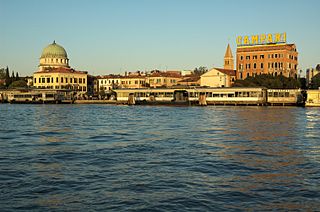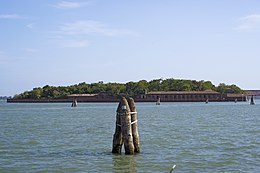
The Lido, or Venice Lido, is an 11-kilometre-long (7-mile) barrier island in the Venetian Lagoon, northern Italy; it is home to about 20,400 residents. The Venice Film Festival takes place at the Lido late August/early September.

The Grand Canal is a channel in Venice, Italy. It forms one of the major water-traffic corridors in the city.

Santa Maria sopra Minerva is one of the major churches of the Roman Catholic Order of Preachers in Rome, Italy. The church's name derives from the fact that the first Christian church structure on the site was built directly over the ruins or foundations of a temple dedicated to the Egyptian goddess Isis, which had been erroneously ascribed to the Greco-Roman goddess Minerva.

Dorsoduro is one of the six sestieri of Venice, in northern Italy.

San Giorgio Maggiore is one of the islands of Venice, northern Italy, lying east of the Giudecca and south of the main island group. The island, or more specifically its Palladian church, is an important landmark. It has been much painted, featuring for example in a series by Monet.

Mazzorbo is one of various islands in the northern part of the Lagoon of Venice. Like the other islands in this part of the lagoon, it was the site one of the earliest settlements in the lagoon which predated the development of Venice. However, these islands then declined and were eventually abandoned. In the 1980s the architect Giancarlo De Carlo built a brightly coloured residential neighbourhood to help to repopulate Mazzorbo. In 2019 its population was 256. It is linked to Burano by a wooden bridge. It was once an important trading centre but is now known for its vineyards and orchards. Its main attraction is the fourteenth century church of Santa Caterina.

Santa Maria delle Grazie is a church and Dominican convent in Milan, northern Italy, and a UNESCO World Heritage Site. The church contains the mural of The Last Supper by Leonardo da Vinci, which is in the refectory of the convent.

The Gallerie dell'Accademia is a museum gallery of pre-19th-century art in Venice, northern Italy. It is housed in the Scuola della Carità on the south bank of the Grand Canal, within the sestiere of Dorsoduro. It was originally the gallery of the Accademia di Belle Arti di Venezia, the art academy of Venice, from which it became independent in 1879, and for which the Ponte dell'Accademia and the Accademia boat landing station for the vaporetto water bus are named. The two institutions remained in the same building until 2004, when the art school moved to the Ospedale degli Incurabili.

Campagna is a small town and comune of the province of Salerno, in the Campania region of Southern Italy. Its population is 17,148. Its old Latin name was Civitas Campaniae. Campagna is located in one of the valleys of the Picentini Mountains, at an altitude of 270 meters above sea level.

Montevarchi is a town and comune in the province of Arezzo, Tuscany, Italy.

San Biagio di Callalta is a comune (municipality) in the province of Treviso, Veneto, north-eastern Italy.

Castello is the largest of the six sestieri of Venice, Italy.

Le Zitelle is a church in Venice, Italy. It is part of a former complex which gave shelter to young maidens who had no dowry, and is in the easternmost part of the Giudecca island.

Our Lady of Graces or Saint Mary of Graces is a devotion to the Virgin Mary in the Roman Catholic Church. Several churches with this dedication often owe their foundation to thankfulness for graces received from the Virgin Mary, and are particularly numerous in Italy, India, Australia, United States, Portugal, France and the Italian-speaking region of Switzerland. Also it is related to the Marian apparitions in which was revealed the Miraculous Medal, also known as the Medal of Our Lady of Graces.

Francesco Tironi was an Italian painter, active in painting vedute of Venice in a Neoclassical style.

The Barbarigo Altarpiece or Enthroned Madonna and Child with Angel Musicians and Saint Mark, Saint Augustine and Doge Agostino Barbarigo is a 1488 oil painting on panel by Giovanni Bellini, now in the church of San Pietro Martire in Murano.

The Nativity Triptych is a 1464–1470 tempera on panel altarpiece by Giovanni Bellini and others. Its central panel of the Nativity measures 127 by 48 cm, its lunette of the Holy Trinity flanked by Augustine and Dominic 59 by 170 cm and its side panels of Francis of Assisi and Victor 103 by 45 cm. It is housed in the Gallerie dell'Accademia in Venice.

The San Lorenzo Triptych is a tempera on panel altarpiece by Giovanni Bellini and others. Its central panel of Saint Lawrence measures 127 by 48 cm, its lunette of the Madonna and Child 59 by 170 cm and its side panels of John the Baptist and Antony of Padua 103 by 45 cm each. It is now in the Gallerie dell'Accademia in Venice.

The Triptych of the Madonna is a 1464–1470 tempera on panel altarpiece by Giovanni Bellini and others. Its central panel of a standing Madonna and Child measures 127 by 48 cm, its lunette of the Man of Sorrows flanked by angels 59 by 170 cm and its side panels of Jerome and Louis of Toulouse 103 by 45 cm. It is now in the Gallerie dell'Accademia in Venice.
Ammiana was a settlement in an archipelago in the northern part of the Lagoon of Venice which has disappeared. Its islands were part of a larger number of islands in this part of the lagoon which also included the island group of the next-door settlement of Costanziaco and the islands of Torcello, Burano and Mazzorbo to the south-east. The islands of Ammiana were between the right and left banks of the lagunar channels which today are called della Dolce and San Felice. Another island, which was called tumba della Leseda and is now called La Salina, which lies on the right (eastern) bank of the San Felice channel, was also part of this settlement.























